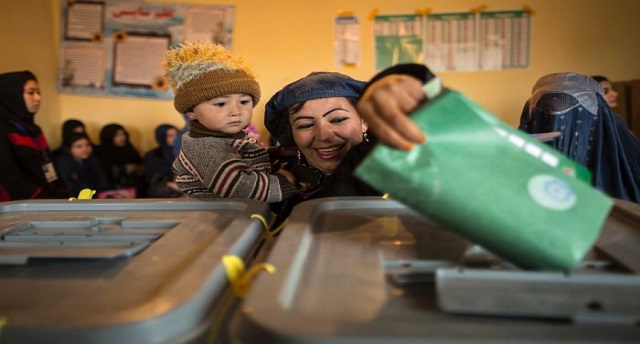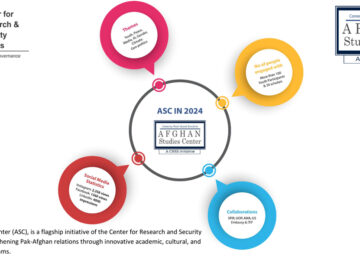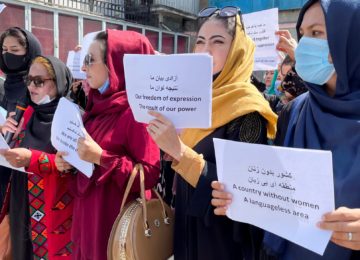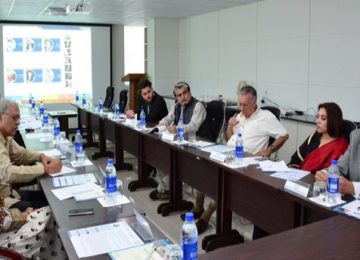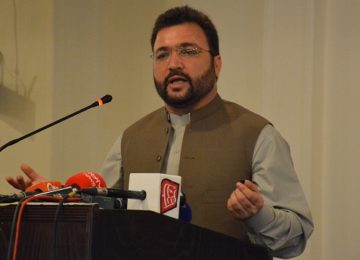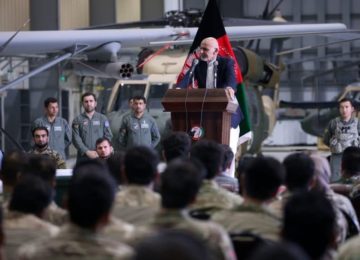December 20, 2017
It looks increasingly unlikely that the next parliamentary (and district council) elections can be held as planned on 7 July 2018. Although the Independent Election Commission (IEC) continues its preparations for the polls, important questions remain unresolved. Due to a lack of consensus, the electoral system remains unchanged, but the IEC has been grappling with the question of whether to stick to the old electoral constituencies or to divide them. The IEC has submitted its proposal on electoral constituencies to the cabinet, but no decision has yet been taken. The following article AAN article takes a close look at the IEC’s proposal and the impact of the government’s indecision.
The choice of electoral system and how electoral constituencies are drawn up largely define political representation in the parliament and may also have an impact on the quality of the elections (1). Although the electoral system will not be changed for the upcoming elections, it is still unclear if the electoral constituencies could be changed. Before delving into the question of the constituencies, a brief note on the back-and-forth about the electoral system is useful. Although next year’s planned elections should include district elections, this dispatch mainly considers the parliamentary elections; a future dispatch will look at the district poll, in detail.
Settling for SNTV, again
Afghanistan used the Single Non-Transferable Voting (SNTV) system with province-wide, multi-member constituencies in the parliamentary elections in both 2005 and 2010. The SNTV system was widely criticised by various political groups, both before and after the 2005 elections, for,, among other issues producing a high number of wasted votes, not encouraging the development of political parties and producing a fragmented parliament. Prior to the 2005 elections, the 50 political parties which were registered at the time had demanded a proportional representation (PR) system (see AAN’s previous reporting here). The United Nations also proposed an electoral system based on PR. However, former President Hamed Karzai rejected it and opted for a system based on SNTV. (See AREU’s report).
Attempts in 2008 and 2012 to introduce an alternative to SNTV also failed. The debate began again after the 2014 disputed presidential elections as part of a plan for broader electoral reform. But the Special Electoral Reform Commission (SERC) established in 2015 by the government and a main vehicle driving the reform, also failed to provide an alternative system on which there might be a consensus. Its proposed options for a replacement for SNTV were not adopted by the government. (See AAN’s previous reports on the three alternatives proposed by SERC here and here. The debate has been polarised, as proponents of the different options have considered how particular changes might impact the balance of power in the parliament. Other major concerns have been about the future parliament’s ethnic make-up, its factional and geographical representation, whether the changes would contribute to strengthening political parties or not, and what they would mean for the women’s quota. In a climate of heightened suspicion, it has been difficult for the government and different sides to unite around an alternative to the SNTV (see AAN’s previous report here). As a result, SNTV will be used in the upcoming parliamentary elections.
The unresolved issue of the constituencies
The constitution envisages a maximum of 250 seats for the parliament’s lower house, the Wolesi Jirga. (2) The current Wolesi Jirga has 249 seats, 239 of them are distributed among the 34 provinces in proportion to their population, while ten seats are allocated to Kuchis. The new electoral law promulgated by presidential legislative decree number 105 in September 2016 (see AAN’s previous report about the changes in the new law here) added another seat for the small Sikh and Hindu communities, jointly. (3)
According to the constitution (article 83.5), the electoral constituencies should be determined by the electoral law. The electoral law specifies the constituencies for all elections, except for the parliamentary and provincial council elections. Instead, the electoral law deferred this decision to the IEC. The deferral was a result of the cabinet’s failure to reach an agreement on the type of constituencies for parliamentary and provincial council elections (see AAN’s previous analysis about the disagreement here). (4)) This was basically a refusal to take responsibility for solving this highly political – and mathematically complicated, if not impossible – question.
The women’s quota foreseen in article 83 of the constitution (paragraph 6), namely the fact that the Wolesi Jirga should include, on average, two women from each province, adds to the complexity. Article 35 of the new electoral law reiterated that the IEC needed to observe the constitutional provisions, including those of the women’s quota. However, as the electoral law did not define the constituencies for the parliamentary elections, the IEC had to consider how the women’s seats would be allocated should it propose changing the current electoral constituencies (for example, by separating the constituencies for women’s seats from those of men’s, under option one below) (see also AAN’s previous analysis here).
The legislative decree issued by the president that endorsed the electoral law further instructed the IEC to conduct a technical study within three months on the “better implementation” of article 35 of the electoral law. That is, to come up with a proposal as to how the Wolesi Jirga and provincial council constituencies should be shaped. The IEC was to present its report to the cabinet, which would then review the report and “take a decision accordingly.”
The decision to entrust the IEC with the responsibility for determining the constituencies was not exempt from criticism. For instance, Abdullah Shafai, a member of the Independent Commission for Overseeing the Implementation of the Constitution, argued at that time that this was unconstitutional, because according to article 83 of the constitution, the constituencies should be determined in the election law, which should be passed either by parliament or by presidential legislative decree, and not by the IEC (see here).
The IEC’s consultations on three options for electoral constituencies
In early 2017, the IEC put forward three options for constituencies for public consultation. Consultations were held in particular with political parties, civil society organisations and media in various rounds (one was attended by the author). The three options were (1) switching to single-member constituencies (in a single-member constituency, only one representative is elected from each constituency), (2) retaining the province-based, multi-member constituencies used in all previous parliamentary and provincial council elections and (3) dividing only the provinces with more than six seats into smaller constituencies. (See also this BBC report). The broader issue of whether or not to make a change to the electoral system was not touched upon in this consultations. Below is a brief account of these three options:
Single-member constituencies
According to the IEC, under this option, there would be four types of constituency for the parliamentary elections:
Two country-wide constituencies for the election of the ten Kuchi representatives and the Hindu and Sikh representative;
Province-wide constituencies for the election of the 65 women representatives under their quota;
A division of each of the larger 31 (out of 34) provinces into several single-member constituencies for the election of the 171 (male) seats. This would mean that these 31 provinces would be divided into 171 constituencies for 171 Wolesi Jirga seats; and
Keeping the three smaller provinces with two seats (one for men and one for women) – Panjshir, Nimruz and Nuristan – as they are, meaning each would act as a single constituency for both male and female seats. (5)
It is worth noting that the option of having single-member constituencies, instead of multiple-member constituencies, had already been discussed by the cabinet at the time of the adoption of the electoral law on 22 August 2016. At that time, the cabinet adopted the law “in principle” as it could not reach a consensus on the proposal to shift to a system of single-member constituencies for the parliamentary and provincial councils. A question was raised about its feasibility, for instance, second deputy Chief Executive Muhammad Mohaqeq argued that this would lead to a huge dispute “among the people as to which village should go with which district, and which one is small and which one is big. In this conflict situation, it will just add another dispute.” (See AAN’s previous report here).
Election observers such as Naim Ayubzada, the director of the Transparent Election Foundation of Afghanistan (TEFA) also listed the lack of accurate population data, lack of clarity about district and village boundaries and the dominance of local strongmen as obstacles (see AAN’s previous report here). The single-member constituencies could also split the women’s and the men’s vote. Women candidates would be required to campaign in bigger constituencies, facing even more security issues.
Dividing some provinces into smaller constituencies
In another version of option one, the constituencies for the Wolesi Jirga seats would be sub-divided five-ways. This would basically keep multi-member constituencies but reduce the area in which candidates would have to campaign:
Each of the 22 provinces with one to six seats under the current system would remain one constituency;
Each of the nine provinces with six to 11 seats – Badakhshan (9), Baghlan (8), Balkh (11), Takhar (9), Ghazni (11), Faryab (9), Kunduz (9), Kandahar (11) and Helmand (8) – would be divided into two constituencies;
Each of the provinces with 11 to 16 seats – currently only one, in practice – Nangrahar (14) – would be divided into three constituencies;
Each of the provinces with 16 to 21 seats – again, only one, Herat (17) – would be divided into four constituencies; and
Each of the provinces with more than 25 seats – again, one only, Kabul (33) – would be divided into six constituencies.
On 1 November 2017, IEC spokesman Gula Jan Abdul Badi Sayyed told AAN that the Kuchis had also submitted a proposal to the IEC to divide their constituency into seven that would correspond with the country’s unofficial seven zones (Central, Kabul; Central Highlands, Bamyan; South, Gardez; Southwest, Kandahar; West, Herat; North, Mazar-e Sharif and Northeast, Kunduz). The IEC said that if its proposal on the constituencies was approved by the government, it would also consider the Kuchis’ proposal.
Keeping the current constituencies
Under this option, the countrywide constituency for ten Kuchi seats would remain and the Sikh and Hindu seat would be added; each of the 34 provinces would continue to serve as a constituency for the remaining 239 seats. (see here)
The IEC’s proposal pending the cabinet’s decision
After consultation and debate on the above options, the IEC finally decided to propose the second option to the government and did so on 21 February 2017. On 9 March 2017, Maliha Hassan, a member of the IEC, told AAN that this was “the only reasonable option considering the current circumstances of Afghanistan,” referring to the complexity of dividing the constituencies on the one hand and the provision of the law that calls for dividing them on the other.
The IEC has found itself on the horns of a dilemma. The new electoral law requires it to divide the constituencies, but it was clear that the practicalities would be highly sensitive as it would have to take into consideration the exact distribution of the population and its ethnic composition in the planned constituencies, despite the fact Afghanistan’s election system is not based on ‘ethnic’ constituencies. A division might cut up unofficial political turfs and trigger protests by groups feeling disadvantaged by the new system. The problem is exacerbated by a situation in which population statistics and existing maps are controversial and unreliable (see AAN analysis of debates about the Hazara-Pashtun divide in Ghazni province following the 2010 parliamentary election, for example), the population of the three provinces of Loya Paktia during the 2014 presidential election, to say nothing of security problems.
These dangers were also pointed out by the IEC during their presentations. On 13 December 2017, Shahla Haq, head of the IEC training department, told AAN that the IEC proposal had not included any detail as to how the provinces should be carved up into the smaller constituencies. According to her, it would require another procedure and a technical team composed of representatives from bodies such as the Independent Directorate of Local Governance (IDLG) and Geodesy and Cartography to set the criteria and divide the proposed provinces accordingly.
Continued cabinet indecision about electoral constituencies
The cabinet has put off making a decision on whether it approves the IEC proposal or decides differently. On 13 December 2017, acting spokesman for the president, Shah Hussain Murtazawi, refused to clarify in a conversation with AAN whether the cabinet would discuss the issue anytime soon. According to some Afghan and foreign observers AAN spoke to, the government’s indecision on the IEC proposal about the constituencies is deliberate, as it intends to finally ask the IEC to stick to the previously used multi-member, province-wide electoral constituencies.
Already in early September 2017 in a proposal seen by AAN, three major political groups – the Council for Protection and Stability, High Council of Jihadi and National Parties, and the New National Front of Afghanistan (see AAN’s previous reporting about their background here and their proposal here) – expressed concern “about the fact that the constituencies are not finalised yet.” They said that this affected the parties’ planning of their lists of candidates, which could not be finalised until the electoral districts had been determined.
According to the IEC electoral roadmap (which AAN has seen a copy of), which still has 7 July 2017 as the date of the elections, the decision regarding the constituencies should have been made by August 2017, more than three months ago. Furthermore, article 36 of the electoral law stipulates that the boundaries of the electoral constituencies should be determined six months before Election Day at the latest. (7) On 14 December 2017, the IEC’s Shahla Haq told AAN that any actions of the body responsible for drawing up constituency boundaries, the IDLG, depend on the cabinet’s decision on what sort of constituencies it wants. The implementation of any decision to redraw any provinces into smaller constituencies would certainly take time. It would also make it increasingly difficult for the election to be held on the scheduled date.
Whatever is decided on constituencies, and whoever finally decides on the practicalities, any change (even if it makes sense in terms of making the election more transparent and acceptable to voters and political forces) will be time-consuming and cause further delays in conducting the next election.
The unresolved issue of the electoral constituencies, along with other problems, such as a lack of clarity about the election budget, the still lingering debate to use of technology in the election and the divisions in the IEC discussed in our previous reports (see here and here) have already pushed the timeline for any 2018 polls back even more.
The Afghan news agency Pajhwok reported on 6 December 2017 that it has seen a new timeline prepared by the IEC, which shows the election will not be held in July 2018. The IEC has not yet confirmed this publicly. A source privy to the internal discussions within the IEC told AAN that the 7 July 2018 date was no longer feasible, but that the IEC continues with its preparations and will decide on a suitable date later in 2018 when there is more clarity. The source said that there was no point in a public announcement of a fall-back date at this stage.
(1) In this piece, electoral districts and constituencies are used interchangeably. Afghan law, though, uses “electoral constituencies” in its English translations. The Dari term is hawza-hayi entekhabati, and in Pashto it is da takanizu hawzu. The choice of electoral system and constituencies affects political representation. For instance, in First Past the Post (FPTP), a form of plurality/majority electoral system applied in single-member constituencies, can ensure geographical representation and maximise representatives’ accountability to their constituents, while a proportional representation with a countrywide constituency contributes to the development of political parties, but may undermine geographical representation. The choice of electoral system and constituencies also affects the quality of elections in terms of the percentage of votes being translated into seats. For instance, the Special Electoral Reform Commission in its proposal for electoral reform said that the current Wolesi Jirga, which was elected under SNTV in 2010, represented only 38 per cent of votes, meaning around 62 per cent of votes cast were wasted in that they did not translate into seats.
(2) Article 83 of the constitution reads:
Members of the House of People shall be elected by the people through free, general, secret and direct balloting.
The work period of the House of People shall terminate, after the disclosure of the results of the elections, on the 1st of Saratan of the fifth year and the new parliament shall commence work.
The elections for members of the House of People shall be held 30-60 days prior to the expiration of the term of the House of People.
The number of the members of the House of People shall be proportionate to the population of each constituency, not exceeding the maximum of two hundred fifty individuals.
Electoral constituencies as well as other related issues shall be determined by the elections law.
The elections law shall adopt measures to attain, through the electorate system, general and fair representation for all the people of the country, and proportionate to the population of every province, on average, at least two females shall be the elected members of the House of People from each province.
(3) Article 48 of the electoral law reads:
Wolesi Jirga has (250) seats; out of which (239) seats are allocated to provinces in proportion to their population, (10) seats are allocated to Kuchis, and (1) seat is allocated to Hindu and Sikhs.
(4) Article 35 of the electoral law says:
The electoral constituencies for conducting presidential, Wolesi Jirga (WJ), provincial council, district council, village council, mayors and members of the municipality council’s elections shall be determined as following:
1- For the Presidential elections, the entire country shall be one electoral constituency.
2- For the purpose of determining electoral constituencies, and dividing them into smaller constituencies, the Commission shall determine the Wolesi Jirga and Provincial Councils electoral constituencies in a manner, in which the provisions of paragraphs (4 and 6) of the article 83 of the constitution are observed.
3- For the district council elections, the entire district shall be one electoral constituency.
4- For the village council elections, the entire village shall be one electoral constituency.
5- For the elections of mayor, the entire city shall be one electoral constituency.
6- For the elections of members of the municipality councils, each Nahia (city district) shall be one electoral constituency. Cities that have not been divided into Nahias, the entire city shall be one electoral constituency.
(5) The constitution reserves at least, on average, two seats from each of the 34 provinces of Afghanistan. Women’s quota seats are thus 68, three of which are allocated to the ten Kuchi seats (article 52. 2 of the electoral says: “Three Kuchi seats are allocated to the female candidates who have garnered the highest number of valid votes in the Kuchi electoral constituency”). If we subtract these 68 women quota seats, one seat for the Hindu and Sikh community, seven male Kuchi seats and three male seats from Panshir, Nimruz and Nuristan from the 250, 171 male seats from 31 provinces will be left, which, according to this option, would be elected from single-member constituencies.
(6) In the 2005 and 2010 parliamentary elections, ten Kuchi representatives were elected in one, country-wide constituency. A 2013 election law (article 23.1) stipulated that the whole country should be divided into seven zones “in a way to consider the presence and movement of [Kuchis]” in those zones (see AAN’s previous report here). However, as Shahla Haq from the IEC told AAN on 14 December 2017, that the law was never applied to a parliamentary election (it has been changed). SERC also proposed seven zone-wide constituencies for the ten Kuchi seats.
(7) Article 36 of the electoral law says:
The boundaries of the electoral constituencies shall be determined at least (180) days before the Election Day, by the Independent Directorate of Local Governance with cooperation from the Central Statistics Office and other relevant agencies and in consultation with the Commission.
By Special Arrangement with AAN. Original link.
Disclaimer: Views expressed on this blog are not necessarily endorsed or supported by the Center for Research and Security Studies, Islamabad.



